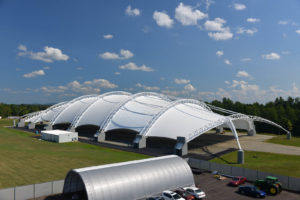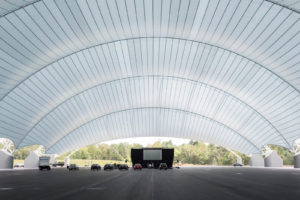
Fabric roofing structure—one of the largest in North America—allows a crash test facility to continue research year-round.
Earlier this year, the National Safety Council estimated motor vehicle deaths to be 8 percent higher in 2015 than they were in 2014—the largest year-over-year percentage increase in 50 years. While a multitude of factors contribute to vehicle crashes, safety precautions can always be improved—a goal the Insurance Institute for Highway Safety (IIHS) has been chasing since 1959.
An independent organization dedicated to measuring the security levels of automobiles, the IIHS has been performing vehicle crash tests at its Vehicle Research Center in Ruckersville, Va., since 1992, conducting up to 70 tests a year. The tests comprise the core of the institute’s vehicle ratings program, which encourages manufacturers to continually improve the crashworthiness of their vehicles.
While the technology used to measure security has consistently evolved over time, the state of the IIHS facility itself was eventually found lacking—so much so that in 2014, IIHS calculated that it lost 100 days of testing on its outdoor track because of rain or snow.
Room for improvement
To improve efficiency, IIHS planned a $30 million facility expansion, identifying, among other updates, the need for a covered track sufficient for the execution of exterior tests on vehicles, which would require installation of a radar system as well as sensors and monitors used to test cars that drive automatically without a driver.
In September 2015, these plans ultimately transformed into a centerpiece five-acre track covered by a steel and fabric roof that withstands the elements, allowing IIHS to test vehicles year-round, regardless of weather conditions. In addition, the existing outdoor track was expanded, bringing the track’s total area—including the covered section—to 15 acres. A new office and conference space were also part of the expansion.
Translucent design
Unfamiliar with fabric structures prior to the start of the roof project, IIHS turned to Dünn Lightweight Architecture, Zapopan, Jalisco, Mexico, because of the firm’s experience building similar structures, says Russ Rader, senior vice president of communications at IIHS. A specialized contractor in fabric and tensile structures, Dünn boasts a portfolio that includes stadiums, fairground enclosures, shopping and recreational centers and sports complexes. “That gave us a lot of confidence because this kind of structure is so unique,” Rader says.
The dome’s design is inspired by Virginia’s rolling landscape, reflecting the track’s surrounding snowcapped mountains.
In order to have as few structural elements as possible, says Andrés Villaseñor, Dünn’s lead engineer on the project, its mountainous size was achieved with a central, 115-foot-high steel arch and three smaller, subsequent arches to the right and three to the left. This allowed Dünn to meet the institute’s request for a clear span of more than 328 feet.
To minimize the need for supplemental lighting, IIHS wanted the roof to transmit as much natural light as possible. Less experienced in working with the large amount and type of membrane fabric required, Dünn partnered with Serge Ferrari North America, Pompano Beach, Fla., to produce a specially manufactured version of Serge’s Précontraint® 1502 T2 flexible composite membrane fabric that transmits 66 percent more light than the standard style.
In addition to translucency, Serge Ferrari’s patented Précontraint technology ensures higher levels of dimensional stability and tensile strength, and the fabric is resistant to weathering, soiling and pollution.
Six fabric panels made from 250,000 square feet of the unique membrane are supported by the seven steel trusses that arc over the 700-by-300-foot track. The panels are supported by 18 concrete piers—each of which is 30 percent underground—weighing a total of 7,000 tons and containing more than 39 miles of steel reinforcement bars.

Location complications
The installation of a project this size—believed to be one of the largest fabric-covered structures in North America—was no easy task in itself, but an additional challenge intensified the difficulty: All of the structure’s components were fabricated by Dünn in Mexico and then sent to Virginia “one by one,” Villaseñor says, where the installation process was completed by a local construction company coordinated and supervised by Dünn.
As with any of its projects, Dünn first conducted a site survey to learn about the conditions of the location, studying wind and snow codes, and any other special requirements, Villaseñor says. “We did formfinding to get a correct geometry, and then the analysis and design of all members of the membrane, such as connections, cables and special fittings.” The next step was confirming the correct sizing of the steel beams and identifying the reaction loads in order to design the anchor elements, he says.
When engineering was complete, plans for fabrication and the erection process were developed before pre-assembling each element for transport via low beds to the installation site.
“We started with the erection of the steel and had to completely finish with all seven trusses and link members before lifting the membranes on-site,” Villaseñor explains. “This was a key element in confirming the steel was in the correct position.”
A crew of 22 people put up the membranes, beginning with a corner panel before moving to each consecutive one until they reached the opposite corner.
“Once the panels were lifted and in position, we connected the clamping system to the steel,” Villaseñor says. “The clamping system is an aluminum profile with a threaded rod; this rod is screwed to the steel. The catenary cables were installed at this stage, and once in final position, the pretension is achieved due to compensation.”
Ready for research
Engineered to withstand a 24-inch snow load capacity and 90-mph winds, the structure was completed within eight months and put to use shortly after its dedication.
“It’s working very well,” Rader said. “We can conduct research, rain or shine, and it also allows us to film the testing using available light without having to add artificial lighting.”
The timing couldn’t be better as IIHS enters a new phase focused on technology that can prevent crashes from occurring in the first place, according to a statement made by Adrian Lund, IIHS president, shortly after the dome’s announcement. “With the expanded facility, IIHS can more quickly evaluate new features that promise to move us closer to the goal of zero crash deaths and injuries,” he said.
Holly Eamon is a business writer based in St. Paul, Minn.
 TEXTILES.ORG
TEXTILES.ORG


